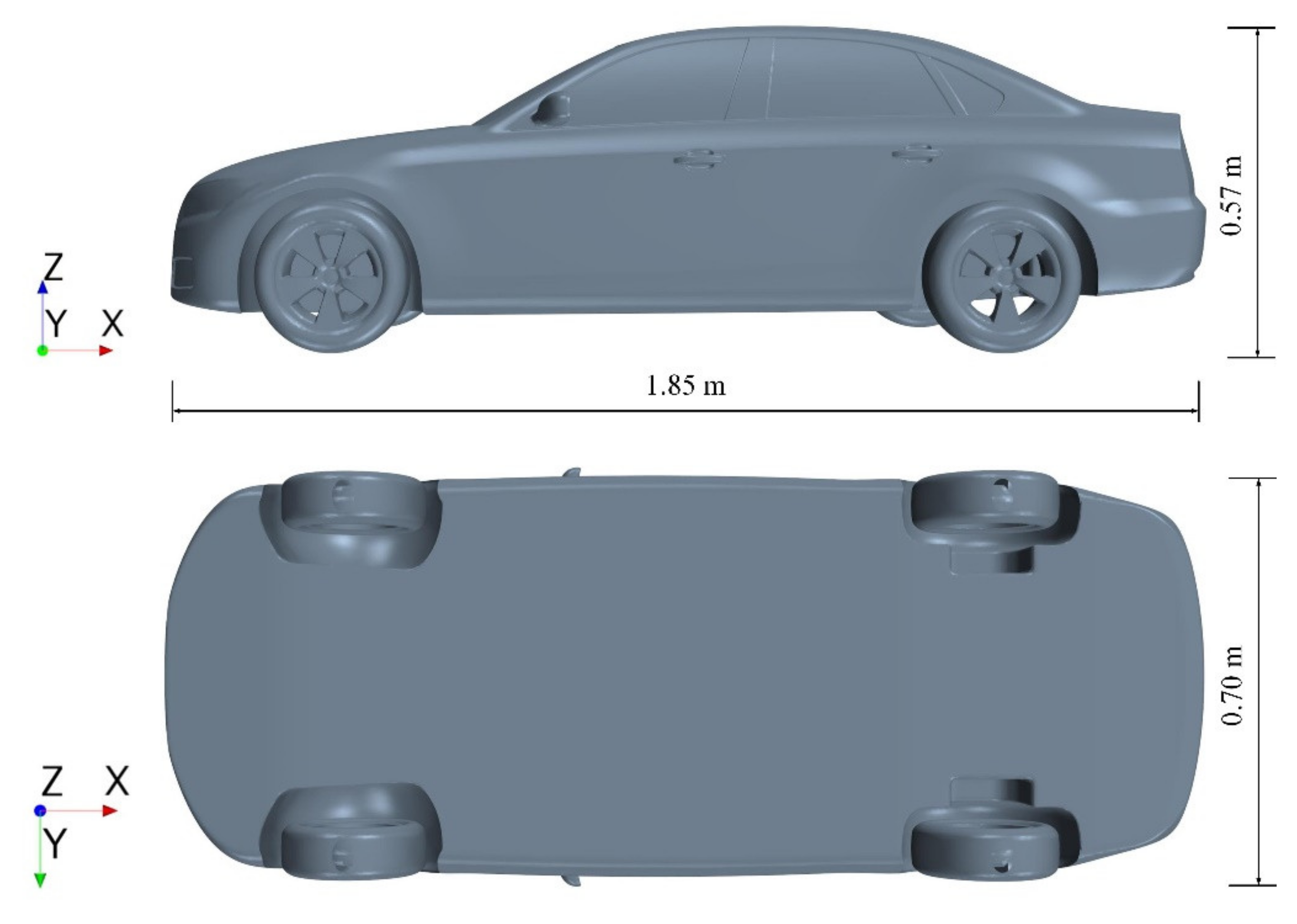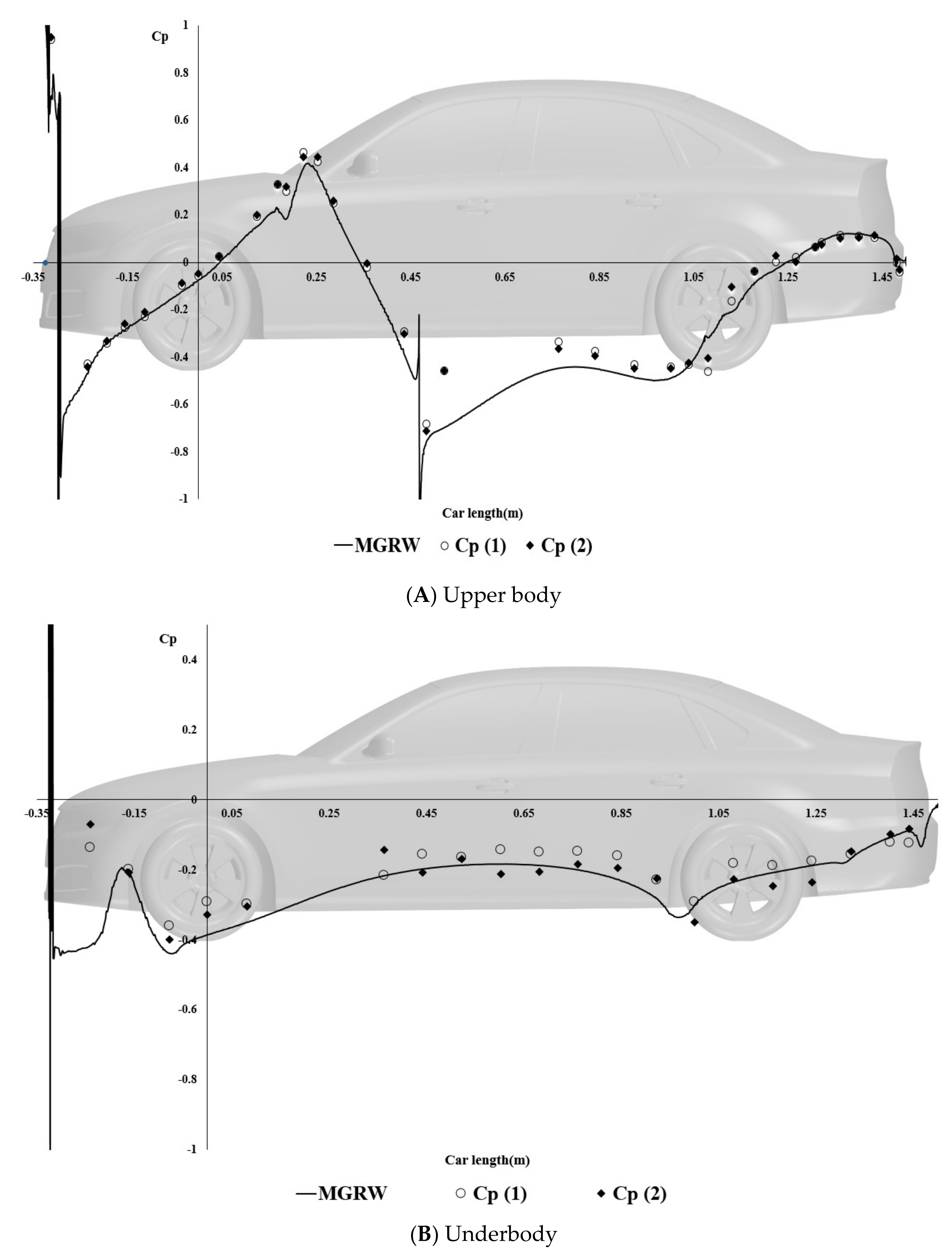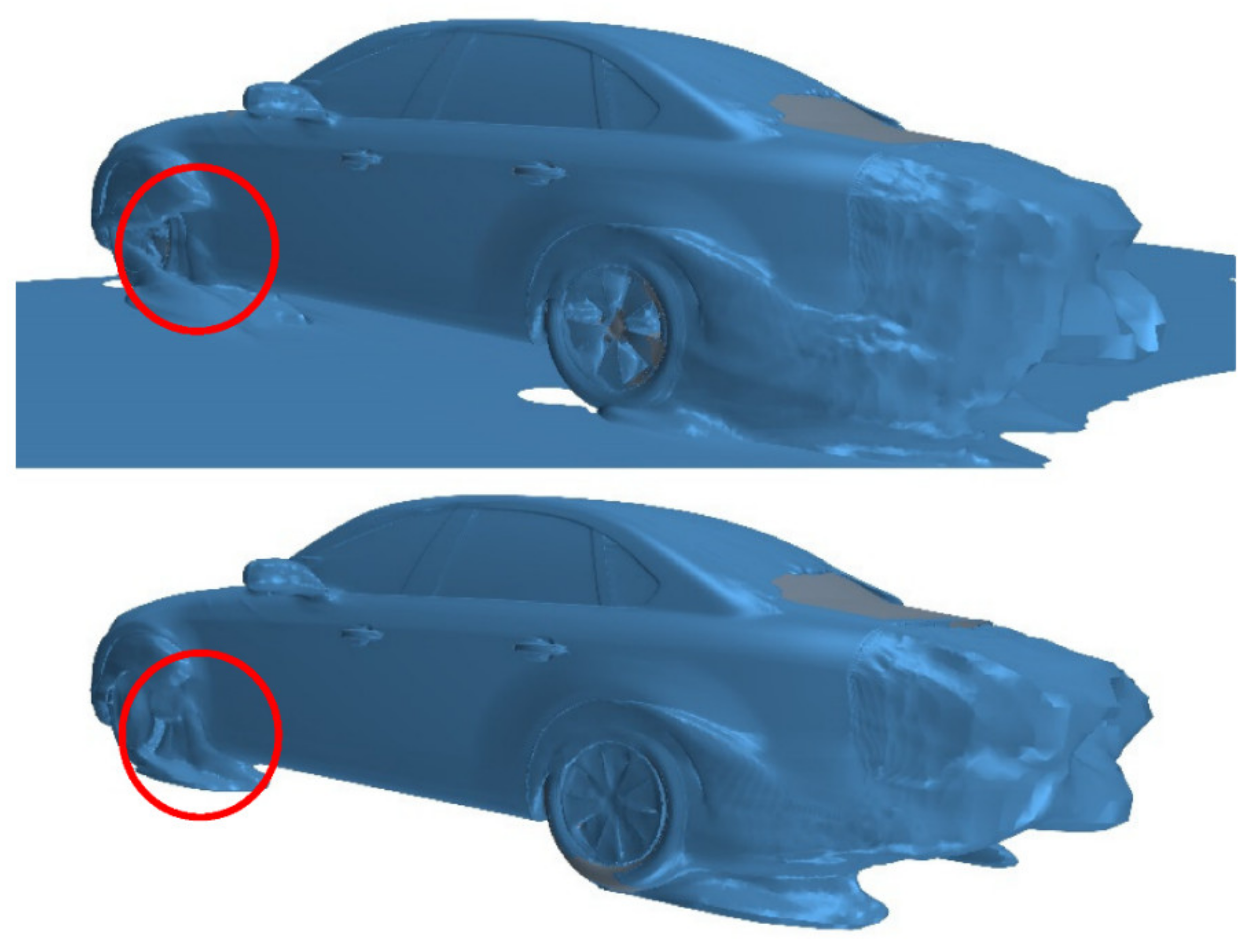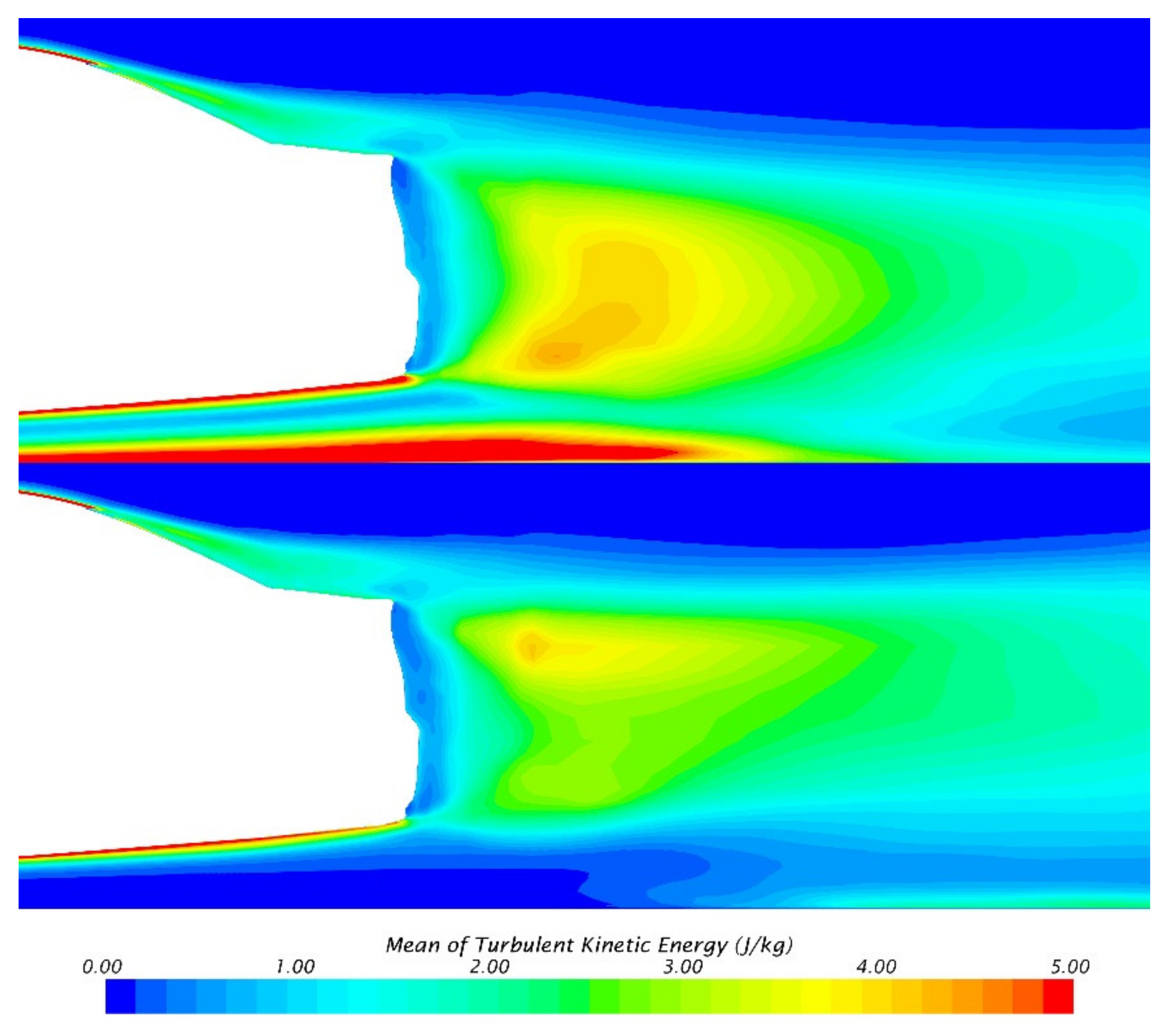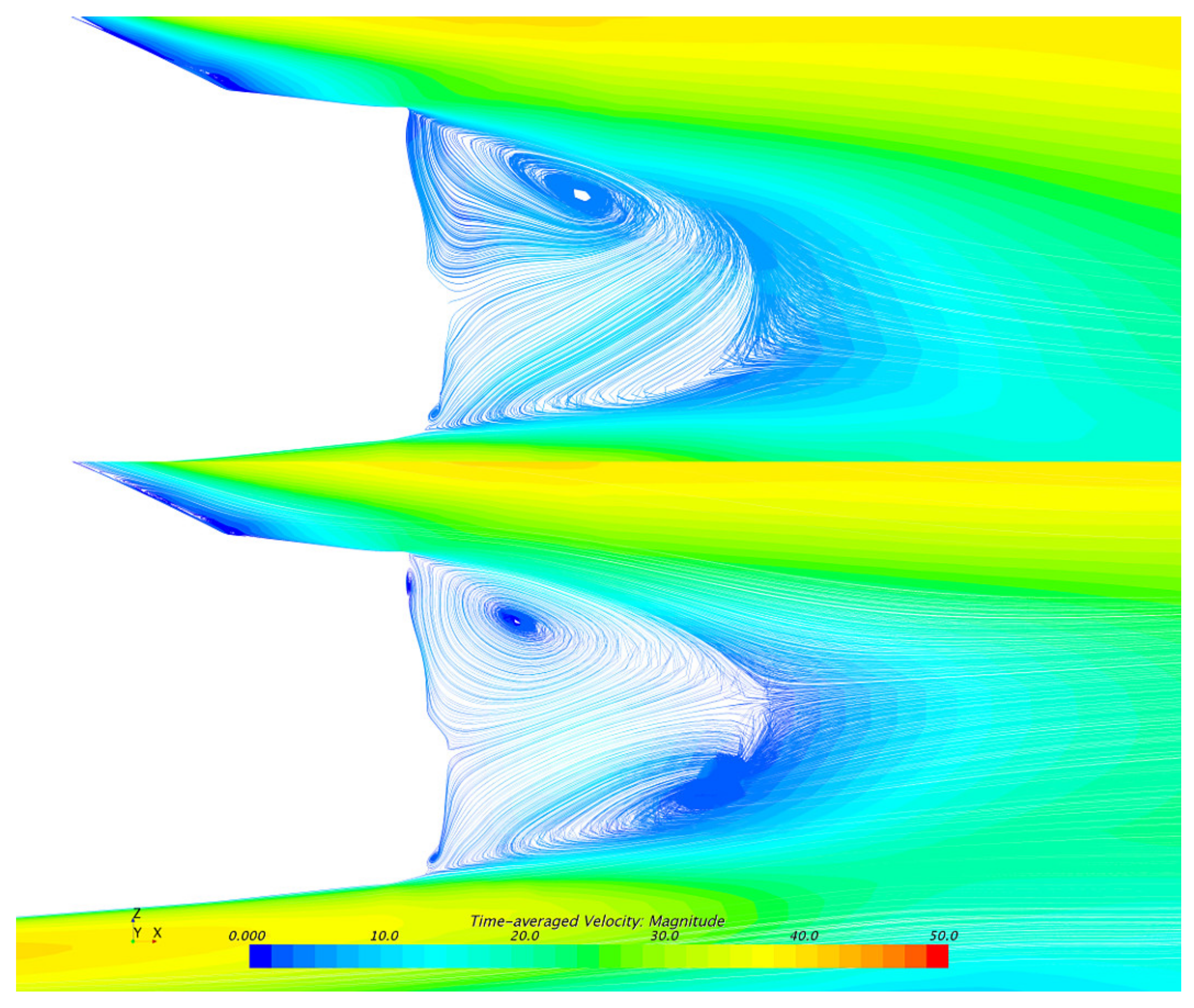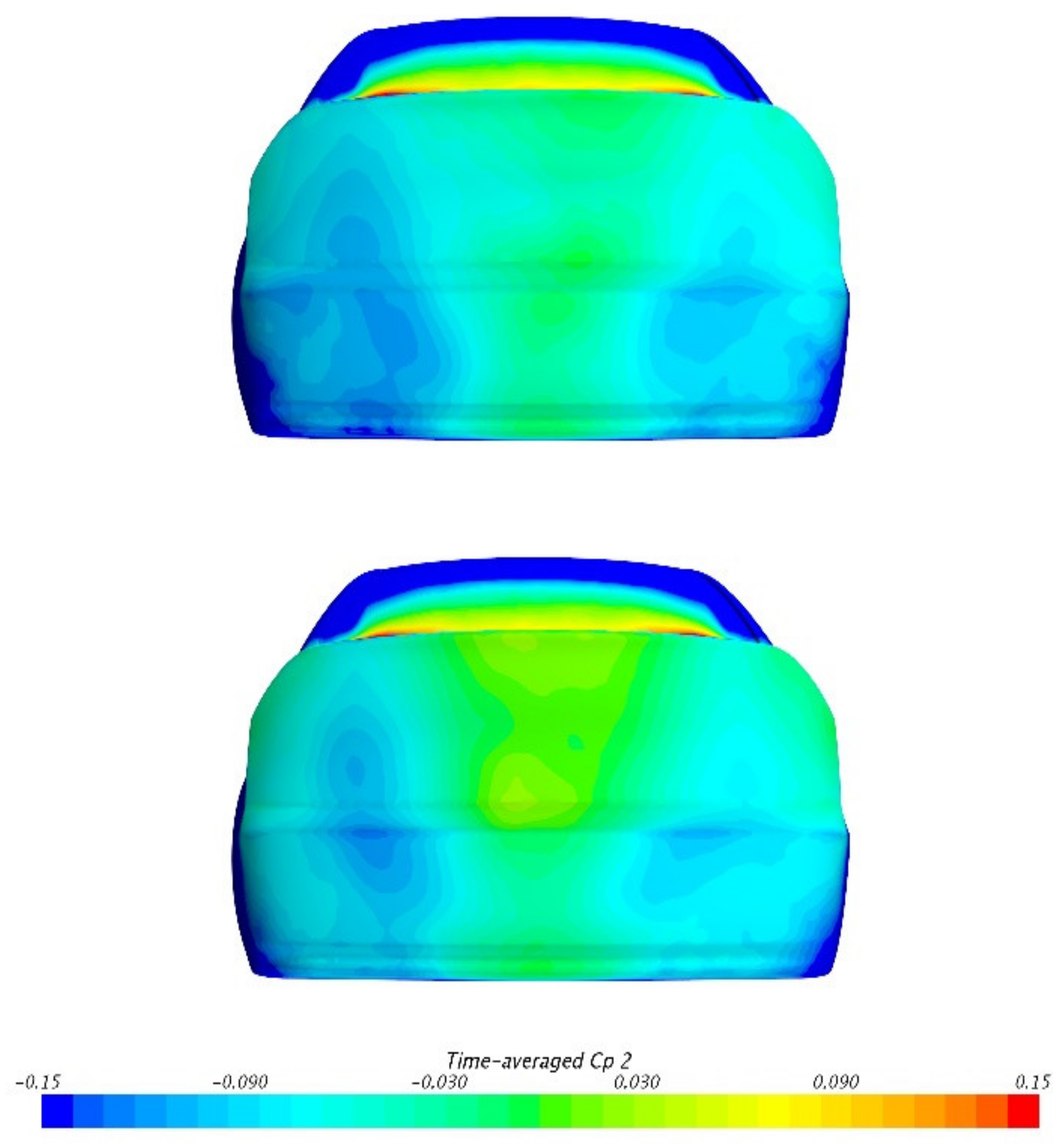3.1. General Uasnderstanding of MGRW
In the first section, it is necessary to compare MGRW with SGSW in order to generally understand the aerodynamic interaction of the wheels and ground in real driving condition. The time-averaged drag and lift coefficients are shown in
Table 4. Compared with SGSW, the total drag coefficient of MGRW decreases by 11 counts, while the body drag coefficient decreases by four counts. This means that the moving ground and rotating wheel condition can reduce the drag on both wheels and the car body, which corresponds to [
3,
13,
14]. Moreover, the lift coefficient decreases by about 100 counts and most of these come from the body. Both the C
D and C
L results indicate significant flow field changes around the vehicle.
As the drag of the car body is mainly affected by the base pressure, it is necessary to investigate the pressure distribution on the base, seen in
Figure 6. It must be mentioned that, in this study, the flow field results around the wake base are not completely symmetrical. It is considered that this phenomenon may result from numerical error from the time-averaged results. However, as the asymmetry of the results is not fundamental and they can still illustrate the main flow field characteristics, they are still considered acceptable. It can be seen that the base can be divided into four sub-regions according to the pressure distribution: Region A and B on the two sides of the base. These two sub-regions account for about 69% of the total base area and the pressure on them is relatively low. Region C is on the upper middle part (24% of the total area) and Region D (7% of the total area) on the lower middle part.
Detailed average C
P values in these sub-regions are listed in
Table 5. As the pressure distribution is not completely symmetrical, Region A and B are considered together. Compared with SGSW, the pressure on Region C is significantly higher in MGRW. The pressure on Region A&B also increases slightly, but the pressure on Region D decreases. The overall pressure discrepancies are consistent with the changes in the C
D body. It must be noticed that, although the area of Region C is smaller, its pressure recovery is about five times larger than that in Region A&B; therefore, this sub-region has the dominant effect on total drag reduction. It can be supposed that Region A and B are related to the wakes of the rear wheels, as the rotating wheel can weaken the vehicle wake near the side of the base [
3]. However, Region C and D are not clearly related to the wheels and ground; therefore, further investigation is required.
Figure 7 illustrates the pressure distribution on the underbody. It is shown that the overall pressure in MGRW is obviously lower than SGSW, which corresponds to their lift coefficients. The decreased underbody pressure is supposed to be generated by the increased velocity of underbody flow, as the moving ground condition can eliminate the ground boundary layers. Moreover, another phenomenon that should be noticed is the low-pressure region behind the front wheelhouses in MGRW (marked in the red oval). However, as mentioned in previous studies, because the rotating wheel can reduce its own wake [
3,
12], the results in
Figure 7 seem to be in contradiction.
Figure 8 shows the time-averaged velocity contour on z = −0.07 m plane. This plane is located beneath the underbody. It can be seen that the velocity after the rear wheels significantly increases in MGRW, which can prove that the rear wheel wakes are weakened by rotating wheels. The width of rear wheel wakes is also reduced, which accelerates the flow between the wheels. Furthermore, the wakes of the front wheels are not obviously altered, which means that the wheel rotation mainly affects the rear wheels.
The total pressure coefficient (C
TP) can be applied to describe the vortex structure in aerodynamic analysis.
Figure 9 illustrates the iso-surface of C
TP = 0, and the differences of the wheel wakes between SGSW and MGRW can be clearly observed. The wake near the bottom of both the front and rear wheels in MGRW is shortened, indicating that the wake is weakened due to the momentum supplement from the rotating wheels. However, the wake of the front wheel becomes longer at the same time (marked in the red oval), which results in the interference on the underbody and the low-pressure region in
Figure 7. Moreover, in MGRW, the wake on the upper part of the rear wheel is also shortened, which also causes the effect of the wake on the left and right side of the car to be weakened,. This is consistent with the pressure recovery in Region A&B in
Figure 6.
Although the local flow field changes near the wheels can be ensured, as the pressure changes in the Region C and D are also very significant, it is necessary to analyze the changes in the flow field in the middle area of the vehicle base.
Figure 10 shows the streamlines on the central plane of the body. In SGSW, the upper and lower vortices are completely asymmetrical: the upper vortex is large in size, while the lower vortex looks small and incomplete. Moreover, the upper vortex is closer to the base and the lower vortex is farther.
However, in MGRW, the sizes and positions of these two vortexes are basically symmetrical. Compared with SGSW, the upper vortex of MGRW has a weaker effect on the base, while the lower vortex has a stronger one. Therefore, this is consistent with the pressure distribution in
Figure 6 and
Table 5 (the pressure in Region C is higher and the surface pressure in Region D is lower). As Region C has the most important effect on the total drag reduction, the symmetrical-wake state may result in lower aerodynamic drag. In this study, this is named the “low-drag state”. This state has some similarities with the Wake Balance state in the literature [
14]. However, Wake balance is defined by the symmetrical turbulence kinetic energy (TKE) and its causes have not been completely understood.
For comparisons with Wake Balance, the TKE on the center plane of SGSW and MGRW is shown in
Figure 11. In MGRW, the TKE in the lower part of the center plane is significantly smaller than that in SGSW, indicating that the vortex in this area has basically formed and the strong velocity pulsation does not exist anymore. However, unlike the Wake Balance [
14], the TKE of the upper and lower parts of the center plane is no longer symmetrical; therefore, the causes of the low-drag state may be different from those of the Wake Balance.
In general, the MGRW state can reduce the aerodynamic drag on both the wheels and the body. This state can weaken the wheel wake and change its structure, reducing wheel aerodynamic drag and affecting the local pressure distribution near the wake. Furthermore, the weakening of the rear wheel wake will also lead to the weakening of the wake on the sides of the vehicle base, leading to pressure decrease in Region A&B. In addition, the MGRW state can also make the upper and lower vortex of the central region become symmetrical, push the vehicle wake to form the low-drag state, affect the pressure in Region C&D and reduce the total aerodynamic drag.
3.4. Comprehensive Investigation of Ground and Wheels
In
Section 3.2 and
Section 3.3, the aerodynamic effects of the ground and wheel states are studied separately. Their influences on the local flow field near the wheel wakes as well as the influences on the aerodynamic characteristics of the whole vehicle are discussed and the mechanisms are also pointed out. Compared with
Section 3.1, most of the flow field changes generated by the different wheel and ground states can be explained. However, there is still a problem that remains unsolved: how do the wheels and the ground affect the flow field near the center part of the base? Although the low-drag state has been discovered, the relationship between the wheels, the ground and this state is not very clear. As mentioned in
Section 3.2.2 and
Section 3.3.2, the center region has the dominant effect on the overall aerodynamic drag; therefore, it is extremely necessary to explore this
According to
Section 3.2 and
Section 3.3, it can be found that the low-drag state is decided by both the ground and wheel states; therefore, their comprehensive effects need to be investigated. Furthermore, even though the specific cause is not clear, it can be supposed that the low-drag state is linked to the flow rate near the underbody. In order to evaluate the lower underbody air flow rate, this study selected a set of sampling planes perpendicular to the
x-axis at the following four important positions near the underbody: the axle of the front wheels (Plane A), the rear side of the front wheels (Plane B), the axle of the rear wheels (Plane C) and the rear end of the underbody (Plane D). The centerline of each sampling plane in y-direction coincides with the centerline of the vehicle body. The widths of the first three sets of planes are set to 0.3 m, and the sampling width of the last set of planes is set to 0.15 m. In addition, since the flow rate near the ground may be affected by the ground boundary layers, each set of sampling planes includes two planes with different heights. Plane one extends from the underbody to the ground, covering the complete ground clearance. Plane two only extends from the underbody to about half of the ground clearance, which is closer to the lower body. The specific location and size of each sampling plane are shown in
Figure 27. In total, eight different sampling planes are generated, which are sequentially numbered as A1, A2, B1, B2, C1, C2, D1 and D2.
Table 14 shows the averaged velocity on the two sets of planes near the front wheels (A and B). It can be seen that the average flow rate is significantly affected by the ground. When the ground is moving, because the ground boundary layer is eliminated, the increase in the underbody flow rate is reasonable. When the wheels are rotating, the airflow rate is slightly lower than the stationary wheel state. This is probably due to the enhanced effect of the wheel wake near the underbody surface, as described in
Section 3.3. However, because the front wheel area is still far from the base of the vehicle, there is no obvious correspondence between the average flow rate on planes A and B and the aerodynamic drag of the car body.
Table 15 shows the flow rate results on the two sets of planes near the rear wheels. Firstly, the results on the C1 and D1 planes are still similar to the results on Plane A and B. Since these two planes cover the entire ground clearance area, the average flow velocity on them is affected by the ground boundary layer, too. Moreover, when the wheels are rotating, the local effect of the rear wheel wake is not as strong as the front wheels; therefore, the wheel rotation will no longer decelerate the airflow of the underbody.
However, on the C2 and D2 planes, the air flow rate is changed significantly. The most noteworthy phenomenon is that there is a corresponding negative correlation between the flow velocity on Plane C2 and the drag coefficients of both the body and the entire vehicle. In MGSW, the flow velocity on Plane C2 is the smallest, and its aerodynamic drag is the largest. As the flow velocity on Plane C2 rises, the aerodynamic drag of the vehicle continues to decrease. In MGRW, the flow velocity on Plane C2 reaches about 36 m/s (90% of the free stream velocity). At this time, the low-drag state is reached, and the aerodynamic drag is also the smallest. On Plane D2, the negative correlation between the air flow velocity and the aerodynamic drag still basically exists, except SGSW. Despite this expectation, it can still be concluded that there is a corresponding relationship between the aerodynamic drag of the vehicle body and the airflow velocity near the rear part of the underbody surface. Combined with the previous analysis, it can be further speculated that there is a connection between the near-wall velocity and the low-drag state.
In order to analyze this relationship, it is necessary to comprehensively compare the flow field characteristics.
Figure 28 shows the streamlines on the center plane in the four conditions. The conditions from top to bottom and from left to right are MGSW, SGSW, SGRW and MGRW, in order. It is not difficult to see that when the velocity near the underbody surface is relatively low, the lower vortex on the center plane is almost completely absent. As the velocity rises, the lower vortex begins to form gradually and eventually grows to a state that is basically equivalent to the upper vortex. At this time, the wake looks symmetrical, and a low-drag state is reached. In this process, the change of the stagnation point is also worth noting. During the continuous development of the lower vortex, the position of the stagnation point is constantly rising. Therefore, it can be inferred that the increase in the flow velocity near the underbody surface can enhance the upwash, which pushes the stagnation point higher and leads to the formation of a lower vortex.
Figure 29 shows the iso-line of u = 0 on the center plane. The overall contour of the recirculation zone can be observed. It can be seen that as the flow rate near the underbody surface increases, the length of the recirculation region also increases, while the height of the stagnation point rises. Commonly, the lengthening of the recirculation region may weaken its effect on the base pressure and result in drag reduction, which corresponds to the results of drag reduction.
However, although the importance of the airflow velocity near the rear underbody surface has been determined and the mechanism is also explained, the relationship between the wheel and the ground states and the flow rate near the underbody is not clear. Based on common sense, when the ground is moving, flow speed near the underbody will naturally increase overall, but the result here is not the case. Therefore, it is still essential to analyze further the physical changes brought about by the different ground and wheel states.
The velocity distribution can be used to analyze the flow field changes in this area intuitively.
Figure 30 shows the velocity contour on Plane D2 and the center plane. It can be seen that when the ground is moving, the velocity gradient near the underbody surface is obviously smaller than that in the stationary ground condition. In other words, when the ground is moving, the boundary layer near the underbody is significantly thicker than that when the ground is stationary (by almost twice). Due to the larger thickness of the ground boundary layer, the lower air flow rate on Plane D2 can be explained. Moreover, it can also be observed that since the wheel rotation can weaken the rear wheel wake, the average flow velocity around the underbody rises. Under this circumstance, although the boundary layer in MGRW is still very thick, the average velocity on Plane D2 is the largest. Results of SGSW and SGRW are relatively close. Although the speed of SGSW is slightly higher than that of SGRW on the left and right sides of Plane D2, resulting in a higher overall speed, in the most important central area the boundary layer of SGRW is also slightly thinner than SGSW; therefore, the speed is also higher.
Through the velocity contour of the center plane, the speed changes near the underbody can be seen more clearly, as shown in
Figure 30B. The position of plane D is also marked in the figure. When the ground is stationary, the thickness of the boundary layer of the ground, which continuously develops from the inlet to plane D, is very considerable. Due to the existence of the ground boundary layer, the airflow passing the ground clearance is deflected upward, squeezing and thinning the boundary layer of the underbody significantly. Therefore, although the presence of the ground boundary layer reduces the air flow velocity in the entire ground clearance region, it can eventually accelerate the flow near the underbody surface. At the same time, since the wheel rotation can weaken the wheel wake and increase the airflow velocity of the lower body, it can further thin the thickness of the boundary layer of the underbody and increase the flow rate near the wall.
In summary, the flow field near the center part of the base is not determined by the overall underbody flow, but by the flow rate near the underbody surface. When the near-underbody airflow is accelerated, the upwash airflow from the underbody becomes stronger. The stronger upwash can gradually oppose the downwash from the upper body; therefore, the stagnation point position is continuously raised, and the vehicle wake becomes longer. Finally, when the airflow velocity reaches a certain level (for this vehicle, the airflow near the rear wheel axis is about 90% of the free stream velocity), the size and position of the upper and lower vortices are basically symmetrical, reaching the low-drag state. At this time, the upper vortex is weakened and its impact on the surface pressure in Region C is reduced, resulting in an increase in the surface pressure and a decrease in the aerodynamic drag of the body and the entire vehicle. The influences of the ground and wheels on the airflow near the underbody surface mainly come from the changes in the average flow rate near the rear underbody. When the ground is stationary, the ground boundary layer is fully developed, which squeezes the underbody airflow and thins the boundary layer. Although the overall speed of the underbody airflow is low at this time, the airflow speed near the wall increases. Moreover, the weakening effect of the wheel rotation on the wake of the rear wheels will cause the overall underbody flow rate to increase (although this effect will be weakened by the ground boundary layer), and it will also further compress the underbody boundary layer. Therefore, the air velocity near the wall is also higher, the wake is more symmetrical, and the aerodynamic drag is reduced.
